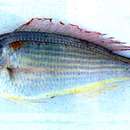en
names in breadcrumbs


Nemipterus japonicus, commonly known as the Japanese threadfin bream, is a marine fish native to the Pacific and Indian Oceans.[1][2] The species now also occurs in the Mediterranean, having invaded as a Lessepsian migrant through the Suez Canal.[3] It is consumed by humans as an ingredient of crab sticks.[4][5][6]
Nemipterus japonicus, commonly known as the Japanese threadfin bream, is a marine fish native to the Pacific and Indian Oceans. The species now also occurs in the Mediterranean, having invaded as a Lessepsian migrant through the Suez Canal. It is consumed by humans as an ingredient of crab sticks.